August 11 - 17, 2019: Issue 416
The Restoration Of The Big Scrub Project Reminds Us Spring Is Almost Here And Local Bushcare Groups Need More Hands For Our Own Local Projects
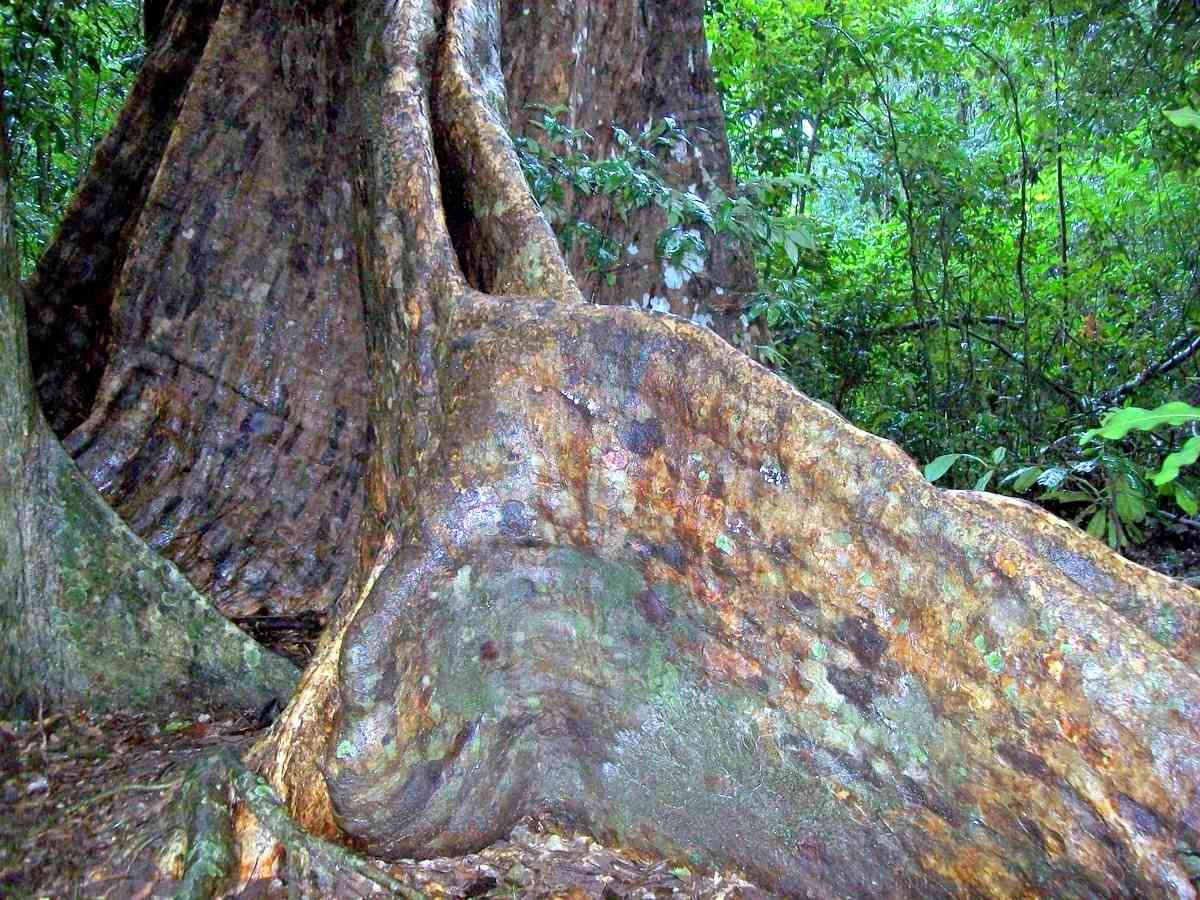
Buttressed roots of a large Francis Water Gum at Booyong Flora Reserve - photo by Poyt448 Peter Woodard - Own work. Syzygium francisii (large) & possibly a White Booyong (small) at Booyong Flora Reserve, NSW, Australia. (Photographed during and after rain) - photo taken 23 June 2010. CC0
WARNING: Aboriginal and Torres Strait Islander readers are warned that the following article contains an image of deceased persons.
A few years back we Pittwater Online was privileged to share an insight into the life of Jim Somerville AM, Narrabeen gentleman, and his work over ten years to prevent the destruction of the Border Ranges National Park near Murwillumbah and the consequent World Heritage listing for the park.
From the same area comes a great news story about the restoration of The Big Scrub by the Big Scrub Landcare group.
The Big Scrub was the largest area of subtropical lowland rainforest in eastern Australia. Located on the North Coast of New South Wales, between what is now the towns of Byron Bay (east) and Lismore (west), the core Big Scrub area consisted of an estimated 900 square kilometres (over 75000 hectares) of subtropical rainforest prior to European settlement. It primarily grows on fertile basalt and floodplain derived soils.
It was intensively cleared for agricultural use in the 19th century by colonists. Only a few remnants survived the clearing, with less than 1% now existing.
The Big Scrub existed in the Bundjalung Aboriginal Nation. Traditionally the Bundjalung (particularly those that spoke the Widgjabal language of the Bundjalung nation) traversed it via walking trails, and maintained a few grassed clearings for camping and hunting within the rainforest. Rainforest bushfoods were a regular part of the traditional Bundjalung diet, including staples like Black Bean, Castanospermum australe, which is detoxified before eating.
The Big Scrub was dominated by White Booyong (Heritiera trifiolata) and Australian Red Cedar (Toona australis). The latter was eagerly sought by the 'cedar getters' settlers for its fine quality timber.
This is the third of a weekly series of articles on the Big Scrub by Mr. Arthur Cousins, who first saw the area in I888, as a teacher at McLean's Ridges School.
MANY VALUABLE TIMBERS IN BIG SCRUB.
Many of the early settlers found white beech to be a good timber for house building.. They used it for walls and floors, cutting it themselves by hand in saw pits on their own property.
With long pit saws, one; above and one below, and with patient labour they cut the logs into flitches about nine inches wide. The top sawyer worked along a chalk line. It was remarkable how well these untrained men did the work. Then, from the flitches, they cut the slabs about 11 inches thick, or flooring. The frames of, the houses were also of beech.
The house in which I first lived on the Richmond, that of Mr. John McLean, father of Mr. Sam McLean, was of white beech. The school at McLean's Ridges was of yellow beech.
BEECH is an easily worked timber, very durable, and one of the best in the world for wood-carving. One of its peculiarities is that in seasoning it, dries only at the surface and shows moisture if a shaving is pared off after several years. Both varieties of beech are large trees and long logs, were often nearly five feet in diameter at the smaller end.
HOOP PINE was very plentiful in the Big Scrub. It was a very tall tree, often showing its top above the rest of the scrub. It was straight and each tree produced many logs, often over, five feet in diameter.
Being light, it was easily floated. Flooded streams were sometimes used, as with cedar, to get the logs to some point of navigation. As late as the nineties quite a deal of pine was drawn by bullocks into the surf at the south end of Tallow Beach and towed to a steamer waiting under the shelter of Broken Head. But if the wind suddenly changed to the north-east, the steamer had to rush away and some of the pine was lost. In the eighties and nineties a great deal of pine was cut and milled. It was easy to work, but white ants were very destructive.
TEAK was the hardest of the scrub timbers — as hard as iron bark. It sometimes chipped the axes of the timber getters. Sometimes it was very cross grained, and hard to split. Its seeds were enclosed in hard five sided pods which when ripe, would burst and scatter the seeds.
When grown in the open, the teak becomes an excellent shade tree. One such tree is growing in Hyde Park, Sydney, near Captain Cook's statue. In the Scrub, however, the teak, like all the other trees, was forced upwards. Each tree then becomes tall and straight, yielding many logs of great size.
In the construction of the Lismore-Murwillumbah railway, teak girders 18 inches x 18 inches were cut. To produce these the narrowest part of the log could not be less than 4ft. 6in. in diameter. Teak is highly inflammable and burns readily green or dry.
LONG JACK was a timber much like teak, but its hard seed case was longer and narrower than that of teak
ROSEWOOD, is a timber which, when cut, looks much like cedar. But it is much harder and can be easily distinguished from cedar by its pleasant odour. It takes a fine polish but is not as easily worked as cedar. It was much used for furniture and also for lining houses.
There were two varieties of bean timber, black and red. It is rather hard, and, like practically all scrub timber is a wonderful shade tree when grown in the open - altogether different to the mighty tall timber trees of the dense scrub. Its seeds are in very large pods, two, three, or sometimes more in each pod, and each seed is as big as a golf ball. When grown in the open the tree looks somewhat like the English chestnut, with its large, pale green leaves growing in pairs.
For years the settlers found no better use for this timber than posts for barb wire fencing. It split easily and, unlike most scrub timbers, did not rot at the surface of the ground.It was found, however, to polish well, and from about 1890 was used extensively by a company for piano frames. It became a common sight to see bean logs on the road side near the Scrub, awaiting transport, along roads to the most convenient shipping place. Bullock teams were always used and bogging was not uncommon.
These are only some of the wonderful timber trees of the Big Scrub. There were many trees not used for timber, some of which provided almost limitless, food for the countless birds. Amongst these were the giant fig, red apple, black apple and two varieties of nettle trees broad and narrow leaved.
The two apples had fruit about the size of a small apple with soft flesh. The black apple had hard smooth seed shells over an inch long, used much in early days as ornaments. The broad leaf nettle had leaves nine inches or more in diameter, something like a cabbage leaf in shape. Its innocent flannel appearance was very deceptive, for, when touched, the leaves gave vicious stings as bad as, or worse than, the stings of bees or bluebottles.
The small leaf nettle did not look so innocent. Its surface was glazed in appearance and angry looking; its sting was even worse than that of the broad leaf variety But nature generally provided a remedy for these stings, the cunjevoi, a type of lily whose leaves are an antidote. The wood of the nettle is very soft and useless as timber.
THE FIG TREE was the mightiest of all the mighty trees of the Scrub, often eight feet or more in diameter and with immense buttresses. But it grew from seeds about the size of sand grains, seeds which so much litter some of our parks. As timber it was useless. But it provided food for hundreds of thousands of birds.
Often the seeds germinated in the leaf mould deposited in the fork where a branch went out from some big tree. The tiny plant grew upwards and the tiny rootlets adhered to the bark of the tree which supplied nourishment to the plant. As the fig tree grew up the roots grew down, growing larger and forming a network round the great parent tree. This continued till the roots reached the ground. Then the tree made great headway until it hit the trunk of the parent tree and killed it, taking its place and becoming a much larger tree than the one upon which it had lived as a parasite.
Not only did the fig trees supply an abundance of food for the multitude of pigeons and other birds, but also for flying foxes, which lived in the valleys.
Many Valuable Timbers In Big Scrub (1953, February 14). Northern Star (Lismore, NSW : 1876 - 1954), p. 6. Retrieved from http://nla.gov.au/nla.news-article96463237
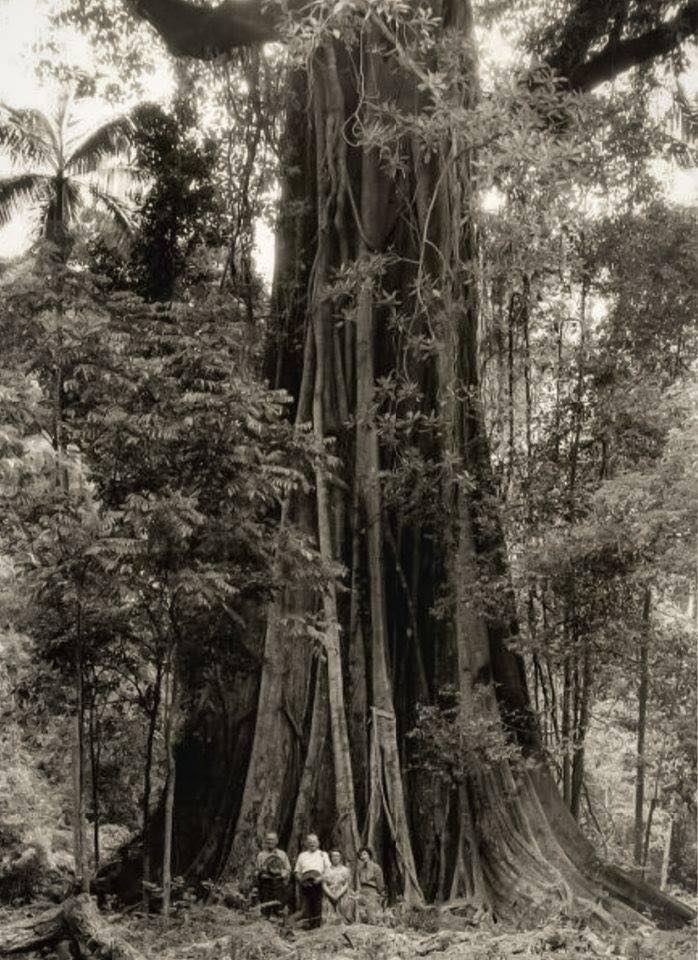
Giant fig tree from The Big Scrub Northern New South Wales, 1953
Later, the Government of New South Wales gave allotments to potential farmers that required them to clear those lands of the rainforest. Hence, most of the Big Scrub was cleared, and the surviving Bundjalung peoples were placed into reservations.
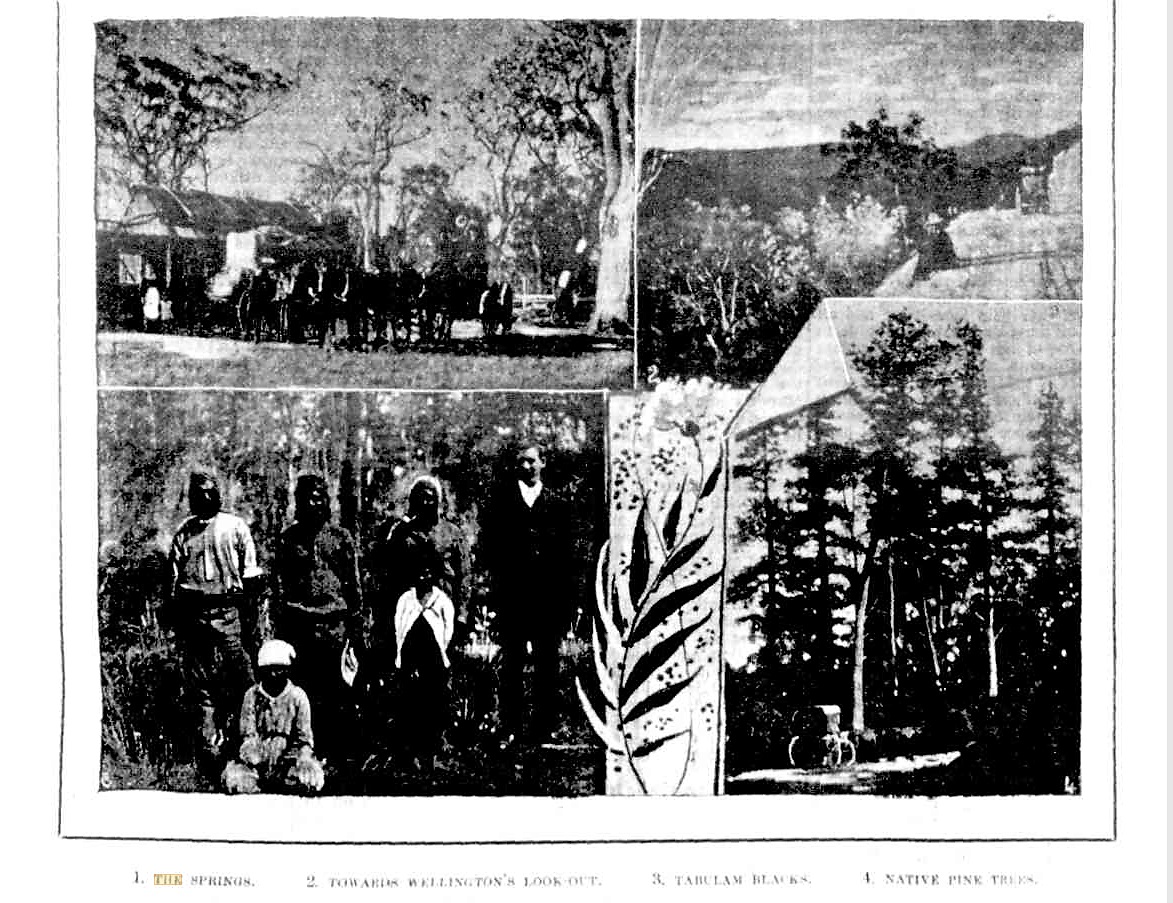
IN THE BIG SCRUB. (1892, January 23). The Australasian (Melbourne, Vic. : 1864 - 1946), p. 41. Retrieved from http://nla.gov.au/nla.news-article138622637
In the 20th century, interest in rainforest and conservation resulted in a greater effort to conserve the few remaining remnants of the Big Scrub. The major remnants are: the Booyong Flora Reserve, Victoria Park Nature Reserve, Davis Scrub Nature Reserve, Boatharbour, and Hayters Hill Nature Reserve. These remnants have been subject to ecological restoration projects which involves the removal of invasive non-native weeds.
Big Scrub remnants have become a source of native foods for cropping, especially in recent years. These include the macadamia nut, riberry and Finger Lime. Macadamia nut is now grown commercially over much of the former Big Scrub area, but the main species used in cropping, Macadamia integrifolia, did not naturally occur in the Big Scrub.
Founded in 1992, The Big Scrub volunteers are one of the largest Landcare groups in the country with more than 400 members and many supporters.
Their stated mission is to to restore and care for this critically endangered rainforest. The major focus is promoting, facilitating and undertaking long-term on-ground restoration and ongoing care of critically endangered lowland subtropical rainforest.
The group works within four key program areas: a Remnant Care Program, Rainforest Re-establishment program, Genetically Diverse Seed Program and a Community Engagement Program.
In broad figures: 25 Years - 55 Projects - $6M Value - 600+ ha Restored - 2,000,000 Trees Planted
In September 2018 Big Scrub Landcare were awarded an Environmental Trust (ET) grant for $100,000 over two years to restore critically endangered lowland subtropical rainforest. This latest grant enabled BSL to continue it’s long-term multi-partnered Rainforest Restoration Programs.
Dr Tony Parkes (President, Big Scrub Landcare) said:
“This latest ET grant marks twenty years of continuous ET funding totalling more than a million dollars. Restoration work in this project will be undertaken at 58 remnant and re-establishment sites in the Big Scrub.“
This project continues the long-term multi-partner program led by BSL to:
- Rehabilitate and provide ongoing management of remnants of critically endangered lowland subtropical rainforest in the Big Scrub, part of the Border Ranges National Biodiversity Hotspot, which will minimise future damage from weeds, pathogens and climate change;
- Protect and enhance the habitat of 54 threatened species;
- Re-establish lowland subtropical rainforest on land from which it has been cleared;
- Enhance connectivity across the Big Scrub landscape, part of the Great Eastern Ranges Corridor;
- Engage with and educate community members and landholders about lowland subtropical rainforest and its restoration.
The major outcomes of this project will see weed infestations reduced and the condition of native rainforest vegetation improved in 46 remnants of Critically Endangered Lowland Subtropical Rainforest and at 8 Lowland Subtropical Rainforest re-establishment sites. The project allows for more than 1000 days of work by bush regenerators.
In November 2018 the group received funding from the NSW Government's Saving Our Species program, which readers will have heard of as being a major factor on the Saving of Grevillea Caleyi at Ingleside.
The group were awarded $290,400 under the NSW Government’s Saving our Species Conservation Co-Funding Scheme for 'a project to conserve and facilitate the recovery of critically endangered lowland subtropical rainforest and its many landscape-managed threatened species'. The Big Scrub Foundation and Big Scrub Landcare are providing another $264,000 in cash co-funding, resulting in $554,400 being available for this vital conservation work over the next 4 years.
In December 2018 Big Scrub Landcare was granted $50,000 from the Australian Government National Landcare Program – Environment Small Grants for rainforest restoration at the Rainforest and Water Reserve at Rocky Creek Dam.
This reserve is habitat for 25 threatened animal species and 9 threatened plant species including the pouched frog, rose crowned fruit dove, Albert’s lyrebird and many species of bat.
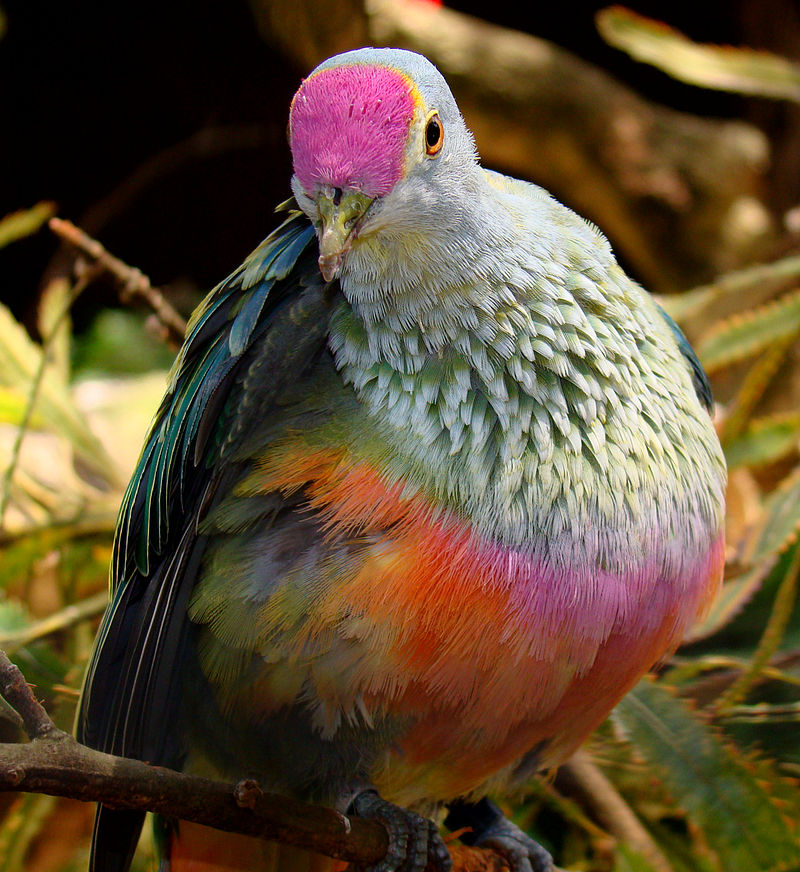
A Rose-crowned Fruit Dove Ptilinopus regina, photographed in captivity in Taronga Zoo in Sydney, Australia. Photo by Bjørn Christian Tørrissen - Own work by uploader, http://bjornfree.com/galleries.html - CC BY-SA 3.0
This project will see critically endangered lowland subtropical rainforest around the dam, the source of our region’s drinking water and adjacent to World Heritage listed Nightcap National Park, restored through systematic weed control over 15 hectares. Weeds including lantana, giant devil’s fig, camphor laurel and privet degrade rainforest and habitat for threatened species. Natural regeneration of rainforest will rapidly replace weeds following control by bush regenerators.
The project is improving the condition of rainforest and habitat for the plants and animals that depend on these areas for survival. That project is being implemented by Big Scrub Landcare with support from Rous County Council and Envite Environment.
In March 2019 BSL hosted 180 students from grades 3 and 4 from 14 schools across the Big Scrub region who came to Rocky Creek Dam to participate in environmental education activities including tree planting, bush walking and learning about drinking water catchments.
The students took part in planting 850 rainforest seedlings to learn about being aware of and taking care for their local ecosystem and catchments. The students learned about the Big Scrub, geology, flora and fauna, history and the community responses and actions for the Big Scrub.
At the end of the session some of the students were asked what they had learnt about the Big Scrub. Some of their responses were:
“If I come back here at the end of high school my trees will be huge”“The rainforest is important for our water”“Planting trees is cool and fun”“I learned that planting trees is really important for the animals and water”“Planting trees helps us to breathe”.
That event was presented by Big Scrub Landcare, Rous County Council, Dorroughby Environmental Education Centre and Lismore City Council with support from Geolink.
The project isn't just about eradicating invasive weeds or restoring the rainforest though. The BSL Program is also developing a living seed bank in the form of plantations that will produce seed from the key species of the ‘original’ forest with optimal genetic diversity for use in restoration plantings.
The total budgeted cash cost of the first plantation, comprising 23 species, is $0.5m, which is supplemented by in-kind contributions of the same amount from the Royal Botanic Gardens Sydney and other partners. DNA sequencing and genome analysis account for two thirds of the costs. Donors to the Big Scrub Foundation, the sister organisation of Big Scrub Landcare, are funding the initial work, which is the collection of leaf samples for DNA sequencing from 3400 trees of 19 species, at a budgeted cost of $70,000. Funding for the balance of $400,000 is being sought from private donors, philanthropic organisations and the Government.
The program is led by Dr Maurizio Rossetto and Dr Robert Kooyman, respectively Australia’s leading rainforest geneticist and research ecologist.
You can read all about that in this July 2019 update.
Each year BSL hosts a 'Big Scrub Rainforest Day'. Held annually in October each year, The Big Scrub Rainforest Day (BSRD) is recognised both regionally and nationally as one of Australia’s premier annual Landcare community engagement events and has attracted over 26,000 attendees since 1999.
The event provides community members with a unique opportunity to learn more about this wonderful, internationally significant local rainforest and its restoration. BSL celebrates community involvement in the ecological restoration of the rainforest through a festival program focusing on ecology, science and the environment.
What a great way to bring focus onto where you're living and celebrate while informing a community on how they can help too.
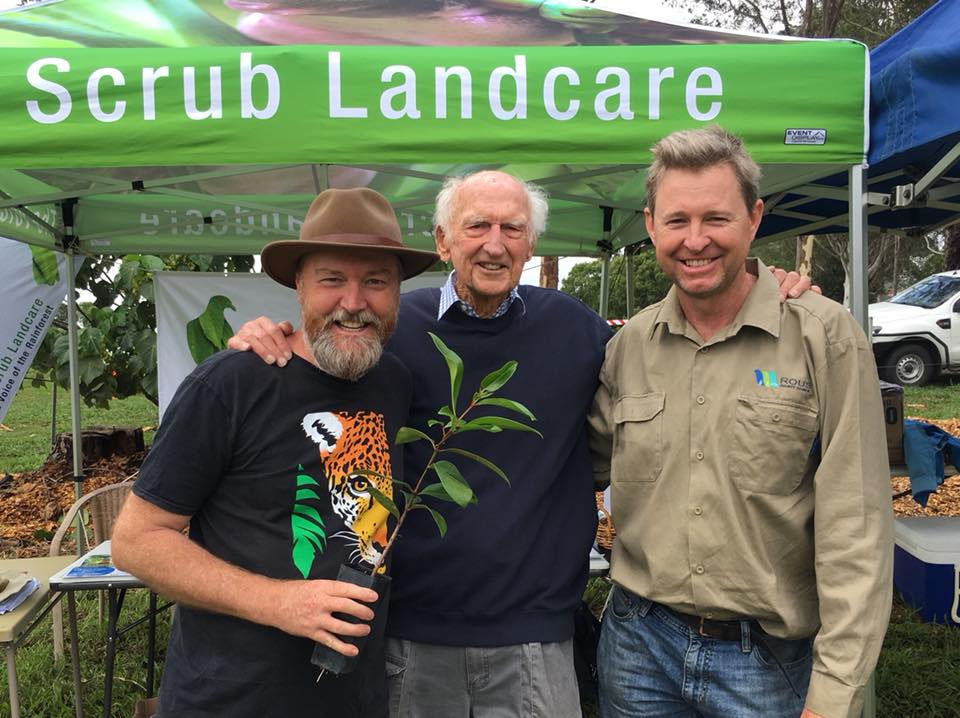
The Big Scrub Rainforest Day community event this morning saw another 1,000 trees planted in partnership with Rous County Council and help from dozens of volunteers. Pictured celebrating another successful event are Kelvin Davies, Tony Parkes and Anthony Acret. - BSL photo, October 15, 2017, by BSL Facebook page
In a week where scientists are renewing calls to protect existing forests (rather than open them up to meet shortfalls in the Forestry Corporation NSW's contracts) and the Intergovernmental Panel on Climate Change has released its long awaited special report on how land use affects climate change, Big Scrub Landcare and a whole community rallying to 'put it back', is a good news story.
BSL brings us a great reminder of how the volunteer community, working in concert with all levels of government, is turning a small tide on what needed to be done decades ago and thankfully is being pursued by many hands today.
As we head towards Spring 2019, and our own local Bushcare Groups head out into the fields to do their utmost to eradicate weeds and plant out species specific to our area, they provide a rallying cry for us all to think about doing what we can everyday to turn 1% back into 100% by 'putting it all back'. In joining a local bushcare group we all contribute to those here right now and future generations being able to access to that long sweet green sigh of relief every natural area provides.
And with Bushcare Groups, here, like there, All Are Welcome - All Belong!
Jim would be pleased!
Bushcare In Pittwater
For further information or to confirm the meeting details for below groups, please contact Council's Bushcare Officer on 9970 1367
BUSHCARE SCHEDULES
Where we work Which day What time
Avalon
Angophora Reserve 3rd Sunday 8:30 - 11:30am
Avalon Dunes 1st Sunday 8:30 - 11:30am
Avalon Golf Course 2nd Wednesday 3 - 5:30pm
Careel Creek 4th Saturday 8:30 - 11:30am
Toongari Reserve 3rd Saturday 9 - 12noon (8 - 11am in summer)
Bangalley Headland 2nd Sunday 9 to 12noon
Bayview
Winnererremy Bay 4th Sunday 9 to 12noon
Bilgola
North Bilgola Beach 3rd Monday 9 - 12noon
Algona Reserve 1st Saturday 9 - 12noon
Plateau Park 1st Friday 8:30 - 11:30am
Church Point
Browns Bay Reserve 1st Tuesday 9 - 12noon
McCarrs Creek Reserve Contact Bushcare Officer To be confirmed
Clareville
Old Wharf Reserve 3rd Saturday 8 - 11am
Elanora
Kundibah Reserve 4th Sunday 8:30 - 11:30am
Mona Vale
Mona Vale Beach Basin 1st Saturday 8 - 11am
Mona Vale Dunes 2nd Saturday+3rd Thursday 8:30 - 11:30am
Newport
Bungan Beach 4th Sunday 9 - 12noon
Crescent Reserve 3rd Sunday 9 - 12noon
North Newport Beach 4th Saturday 8:30 - 11:30am
Porter Reserve 2nd Saturday 8 - 11am
North Narrabeen
Irrawong Reserve 2nd Saturday 2 - 5pm
Palm Beach
North Palm Beach Dunes 3rd Saturday 9 - 12noon
Scotland Island
Catherine Park 2nd Sunday 10 - 12:30pm
Elizabeth Park 1st Saturday 9 - 12noon
Pathilda Reserve 3rd Saturday 9 - 12noon
Warriewood
Warriewood Wetlands 1st Sunday 8:30 - 11:30am
Whale Beach
Norma Park 1st Friday 9 - 12noon
Western Foreshores
Coopers Point, Elvina Bay 2nd Sunday 10 - 1pm
Rocky Point, Elvina Bay 1st Monday 9 - 12noon
Where we work Which day What time
Avalon
Angophora Reserve 3rd Sunday 8:30 - 11:30am
Avalon Dunes 1st Sunday 8:30 - 11:30am
Avalon Golf Course 2nd Wednesday 3 - 5:30pm
Careel Creek 4th Saturday 8:30 - 11:30am
Toongari Reserve 3rd Saturday 9 - 12noon (8 - 11am in summer)
Bangalley Headland 2nd Sunday 9 to 12noon
Bayview
Winnererremy Bay 4th Sunday 9 to 12noon
Bilgola
North Bilgola Beach 3rd Monday 9 - 12noon
Algona Reserve 1st Saturday 9 - 12noon
Plateau Park 1st Friday 8:30 - 11:30am
Church Point
Browns Bay Reserve 1st Tuesday 9 - 12noon
McCarrs Creek Reserve Contact Bushcare Officer To be confirmed
Clareville
Old Wharf Reserve 3rd Saturday 8 - 11am
Elanora
Kundibah Reserve 4th Sunday 8:30 - 11:30am
Mona Vale
Mona Vale Beach Basin 1st Saturday 8 - 11am
Mona Vale Dunes 2nd Saturday+3rd Thursday 8:30 - 11:30am
Newport
Bungan Beach 4th Sunday 9 - 12noon
Crescent Reserve 3rd Sunday 9 - 12noon
North Newport Beach 4th Saturday 8:30 - 11:30am
Porter Reserve 2nd Saturday 8 - 11am
North Narrabeen
Irrawong Reserve 2nd Saturday 2 - 5pm
Palm Beach
North Palm Beach Dunes 3rd Saturday 9 - 12noon
Scotland Island
Catherine Park 2nd Sunday 10 - 12:30pm
Elizabeth Park 1st Saturday 9 - 12noon
Pathilda Reserve 3rd Saturday 9 - 12noon
Warriewood
Warriewood Wetlands 1st Sunday 8:30 - 11:30am
Whale Beach
Norma Park 1st Friday 9 - 12noon
Western Foreshores
Coopers Point, Elvina Bay 2nd Sunday 10 - 1pm
Rocky Point, Elvina Bay 1st Monday 9 - 12noon
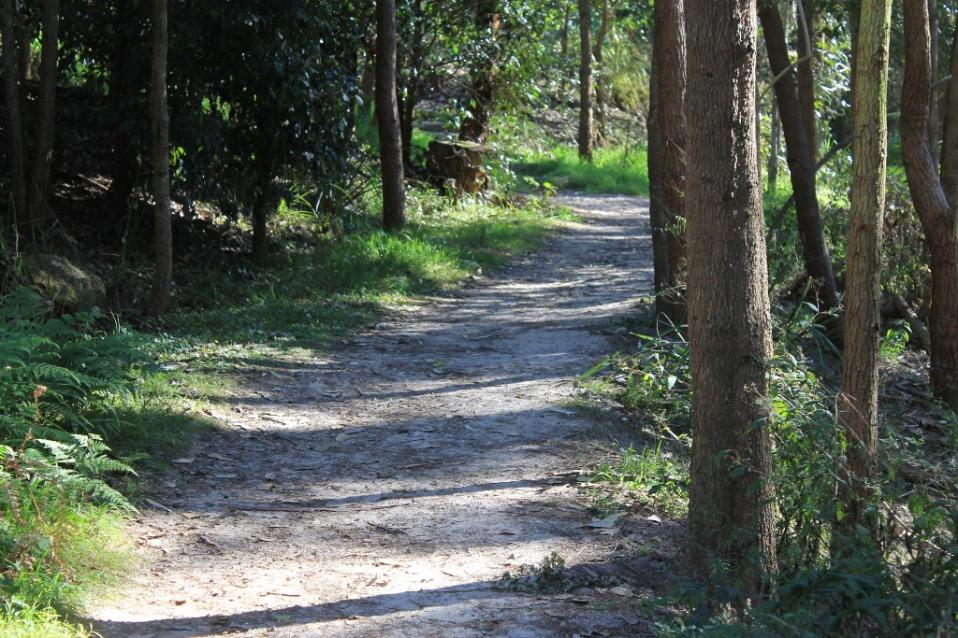
The path to Irrawong, Warriewood- A J Guesdon photo.
Article by A J Guesdon, 2019